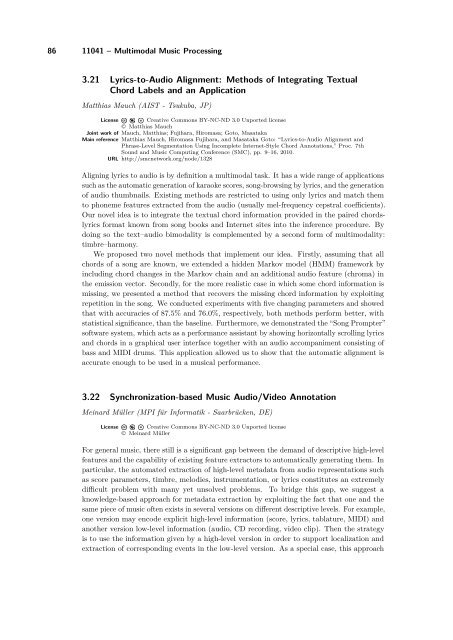Volume 1, Issue 1, January 2011 - DROPS - Schloss Dagstuhl
Volume 1, Issue 1, January 2011 - DROPS - Schloss Dagstuhl
Volume 1, Issue 1, January 2011 - DROPS - Schloss Dagstuhl
Create successful ePaper yourself
Turn your PDF publications into a flip-book with our unique Google optimized e-Paper software.
86 11041 – Multimodal Music Processing<br />
3.21 Lyrics-to-Audio Alignment: Methods of Integrating Textual<br />
Chord Labels and an Application<br />
Matthias Mauch (AIST - Tsukuba, JP)<br />
License Creative Commons BY-NC-ND 3.0 Unported license<br />
© Matthias Mauch<br />
Joint work of Mauch, Matthias; Fujihara, Hiromasa; Goto, Masataka<br />
Main reference Matthias Mauch, Hiromasa Fujihara, and Masataka Goto: “Lyrics-to-Audio Alignment and<br />
Phrase-Level Segmentation Using Incomplete Internet-Style Chord Annotations,” Proc. 7th<br />
Sound and Music Computing Conference (SMC), pp. 9–16, 2010.<br />
URL http://smcnetwork.org/node/1328<br />
Aligning lyrics to audio is by definition a multimodal task. It has a wide range of applications<br />
such as the automatic generation of karaoke scores, song-browsing by lyrics, and the generation<br />
of audio thumbnails. Existing methods are restricted to using only lyrics and match them<br />
to phoneme features extracted from the audio (usually mel-frequency cepstral coefficients).<br />
Our novel idea is to integrate the textual chord information provided in the paired chordslyrics<br />
format known from song books and Internet sites into the inference procedure. By<br />
doing so the text–audio bimodality is complemented by a second form of multimodality:<br />
timbre–harmony.<br />
We proposed two novel methods that implement our idea. Firstly, assuming that all<br />
chords of a song are known, we extended a hidden Markov model (HMM) framework by<br />
including chord changes in the Markov chain and an additional audio feature (chroma) in<br />
the emission vector. Secondly, for the more realistic case in which some chord information is<br />
missing, we presented a method that recovers the missing chord information by exploiting<br />
repetition in the song. We conducted experiments with five changing parameters and showed<br />
that with accuracies of 87.5% and 76.0%, respectively, both methods perform better, with<br />
statistical significance, than the baseline. Furthermore, we demonstrated the “Song Prompter”<br />
software system, which acts as a performance assistant by showing horizontally scrolling lyrics<br />
and chords in a graphical user interface together with an audio accompaniment consisting of<br />
bass and MIDI drums. This application allowed us to show that the automatic alignment is<br />
accurate enough to be used in a musical performance.<br />
3.22 Synchronization-based Music Audio/Video Annotation<br />
Meinard Müller (MPI für Informatik - Saarbrücken, DE)<br />
License Creative Commons BY-NC-ND 3.0 Unported license<br />
© Meinard Müller<br />
For general music, there still is a significant gap between the demand of descriptive high-level<br />
features and the capability of existing feature extractors to automatically generating them. In<br />
particular, the automated extraction of high-level metadata from audio representations such<br />
as score parameters, timbre, melodies, instrumentation, or lyrics constitutes an extremely<br />
difficult problem with many yet unsolved problems. To bridge this gap, we suggest a<br />
knowledge-based approach for metadata extraction by exploiting the fact that one and the<br />
same piece of music often exists in several versions on different descriptive levels. For example,<br />
one version may encode explicit high-level information (score, lyrics, tablature, MIDI) and<br />
another version low-level information (audio, CD recording, video clip). Then the strategy<br />
is to use the information given by a high-level version in order to support localization and<br />
extraction of corresponding events in the low-level version. As a special case, this approach













